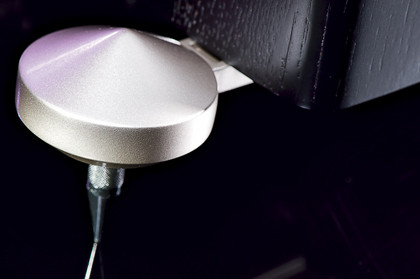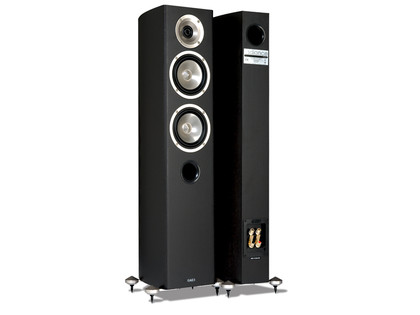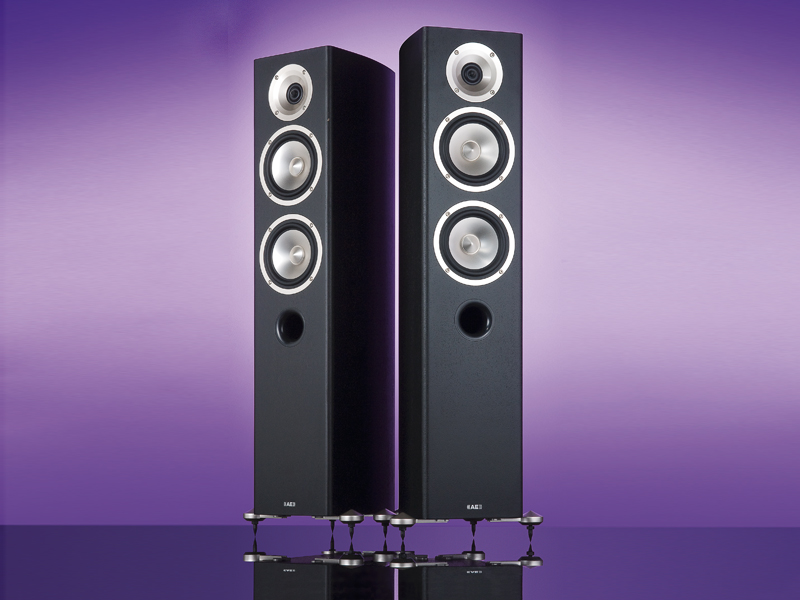TechRadar Verdict
Little to find fault with in this impressive all round performer
Pros
- +
Fine neutrality
- +
Sweet top end
- +
Fine imaging
- +
Wide dynamic range
Cons
- -
Wood veneer could be prettier
- -
Needs more more grunt and dynamic expression
Why you can trust TechRadar
Acoustic Energy's new Radiance 2 model certainly looks the business, from its high-tech DXT tweeter waveguide at the top, down to the substantial and properly engineered outriggers around the base that keep the whole thing from tipping over too easily.
It's also wrapped up in an admittedly rather utilitarian real-wood veneer, all of which seems to represent pretty good value for money at £1,000 for the pair.
Pick of the bunch
The '2' is the middle of three Radiance models and the last to come under Hi-Fi Choice scrutiny. That's because it came rather later to the market, which in turn implies that the engineers spent a little more time refining the design.
In fact, it took at least three years to bring the original Radiance models to market and the extra year spent developing and refining this Radiance 2 model would seem to have been time well spent, even though its similarity to the larger Radiance 3 and smaller Radiance 1 is close and unmistakeable.
However, whereas the Radiance 3 (and for that matter its much less costly Aelite 3 cousin) is a three-way design with twin 160-millimetre bass-only drivers and the Radiance 1 is a simple two-way standmount, this Radiance 2 splits the difference by operating in a two-and-a-halfway configuration.
It has two 130mm drivers, each using 95mm diameter metal alloy cones with AE's characteristic 'pointy' integral dust cover. The upper drive unit operates as a bass/mid unit here, while the lower one just provides some extra bass weight. Both units are separately loaded by their own ported sub-enclosures, the bass-only driver by a front port and the bass/mid unit by a port located high up on the rear.
Although no mention is made in the manual, if the room match at the bass end proves less than ideal, it would clearly be feasible to re-tune the bottom end by blocking one or other (or both) ports.
The cone drive units have undergone considerable development from those used in earlier Acoustic Energy ranges. FEA modelling has enabled the breakup points to be moved to substantially higher frequencies while at the same time reducing the moving mass.
The magnetic motor design has been improved to increase sensitivity and reduce harmonic distortion and thermal compression. The tweeter – common to all three Radiance models – is one of those 'ring radiator' devices, a design that provides termination for both the inside and the outside of a 38mm soft fabric annular diaphragm.

GOOD VIBRATIONS: The uniquely designed cast-alloy outrigger spiked feet are constructed to enhance the performance of the Radiance 2 by providing a vibration-free footing
This is loaded at the front by the DXT lens to smooth the power response through the crossover region and treble proper.Fed from twin-terminal pairs, the crossover network is deliberately kept as simple as possible.
Curvaceous body
The enclosure has attractive and functional curved sides and front edges and is finished in either pale or dark real (albeit rather anonymous) wood veneer. Crucially, it sits on substantial cast alloy outrigger spiked feet that ensure fine mechanical stability. Proper 8mm spikes with real lock-nuts provide good floor coupling.
The construction involves forming the curved sides by filleting the inside of the 15mm MDF panels with closely spaced, deep grooves. This allows the curved shape to be formed, increasing damping but reducing rigidity. Structural integrity is then restored by a horizontal partition that creates the separate chambers for each cone drive unit.
The curved sides are both fashionable and functional, helping disperse internal reflections and avoid generating focused horizontal standing waves. The grille is held by magnets hidden beneath the veneer, so it may be left off without revealing unsightly mounting lugs.
Beautiful balance
While there are some grounds for criticism here and there, our overall reaction to this speaker is very positive, verging on outright enthusiasm. Perhaps reflecting its extended development time, this middle model has the best overall tonal balance of the three Radiance products – not perfect, but close enough for the majority of listeners.
Add to that an enclosure that's clearly well founded, notably free from boxiness and capable of resolving a wide dynamic range, and you're left with a speaker that does very little wrong and most things rather well.
The sound as a whole has a beautifully balanced and voiced midband, with just a touch of nasal coloration audible on speech, but a good sense of overall coherence. There is a touch of timesmear and chestiness, which seems to be an endemic feature of two-and-a-halfway designs, probably because of the way rolling off the bass only driver adds a touch of timesmear through the lower registers.
Unlike many small speakers, however, the Radiance 2 has a realistic warmth through the bass region. And although those two small drive units are never going to deliver a huge amount of serious bass welly and weight, what there is remains convincing enough, with well-judged average output level, if not the smoothest delivery.
Space and air
Although the speaker is physically quite short, placing the drive units a little below seated ear height, the stereo imaging is still attractively spacious, enhanced by the impressive freedom from boxiness. Superior dynamic range, fine focus and delicacy, a sweet top end and a mostly smooth midband, all help deliver a good sense of air and space and the soundstage shows no tendency to hang around the boxes.
Depth perspectives are well portrayed, especially on choral recordings that are accompanied by a large and believable acoustic. The enclosures are particularly effective at eliminating boxy effects and enhancing the dynamic range.
Low level cabinet noise, which can often obscure fine detail at the low end of the dynamic range, seems exceptionally well-controlled here and the result is a speaker that sounds impressively 'clean'. However, although the dynamic range is unusually wide, the actual dynamic behaviour does fall a little short. Music is driven along with decent pace, but the bass lacks a little grip and tension compared to the best.

The sweet and smooth top end, supplying plenty of subtle detail without ever seeming to draw attention to itself, provides fine vindication for both the choice of tweeter and the effectiveness of the DXT waveguide.
It does indeed seem a shame that the Radiance 2 didn't get the chance to go head-to-head with our group test contenders, as it's clearly a very competitive prospect. The tonal balance is very well-judged, the dynamic range is wide and stereo images are well formed.
The veneer work might not be the prettiest, but the provision of proper and substantial floor-coupling outriggers is a major and very worthwhile bonus.
Follow TechRadar Reviews on Twitter: http://twitter.com/techradarreview
